Special Report
The Most (and Least) Healthy Countries in the World
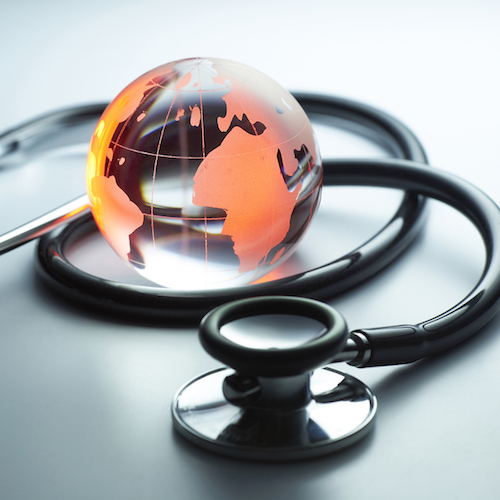
Published:
Last Updated:

Many factors contribute to the health of a population, and worldwide health varies to the extreme. While most Americans are aware that these global health disparities exist, a look at the health outcomes of each country’s population reveals the extent of these massive health differences.
In the United States, which has its own well-documented health issues, the average person born today can expect to live to be about 79 years old. In the southern African nation of Swaziland, life expectancy is three decades shorter. It should be noted that the U.S. ranks behind 30 other nations longevity.
[in-text-ad]
Although it is certainly important, the quality of a country’s health care system is not the only factor contributing to the health of a population. Poverty, the regional presence of disease, and health behaviors all help determine both quality and length of life. Reviewing health factors such as life expectancy, maternal and infant mortality rates, and the incidence of tuberculosis, 24/7 Wall St. identified the healthiest and least healthy countries. Based on our analysis, Iceland is the healthiest nation, while the southern African nation of Lesotho ranks as the least healthy.
Click here to see the healthiest countries.
Click here to see the least healthy countries.
The relative affluence of a region can have wide-reaching implications on the health of its populace. Extremely poor populations are more likely to live in conditions that put them at greater risk of illness. They are less likely to be able to afford proper nourishment, and more likely to experience stress, which can affect health as well.
Those with little or no disposable income are also much less likely to be able to afford proper health treatment. On a national level, governments and private health enterprises with fewer resources are less likely to be able to provide needed treatment.
Greater health spending is by no means a guarantee of better health outcomes. For example, health spending per capita in the United States is higher than nearly any nation on Earth, but U.S. health ranks behind dozens of nations on this list. However, there appears to be a minimum threshold of health spending necessary to maintain adequate public wellness. The world’s healthiest nations tend to spend more on health than others, and in many of the least healthy nations, spending amounts to a tiny fraction of that in the most developed countries.
In each of the 10 healthiest nations, spending ranges from at least $1,610 per person to $9,674 per person. Among the least healthy nations, health spending ranges from $570 per person in South Africa to just $15.60 per person in the Central African Republic.
The relationship between spending and health outcomes likely points not to prices of care, but to access and use of treatment. It is probably no coincidence that many of the healthiest nations have some form of government subsidized or wholly-funded health care. In Iceland, not only is health care provided by the government, but registration with a general practitioner is compulsory, which contributes to residents’ access to care and increases preventive practices.
One of the major differences between the healthiest and least healthy nations is the presence of preventable illnesses. While tuberculosis, a treatable illness with an existing vaccine, has been effectively eliminated as a threat in most industrialized countries, it remains a serious problem in developing nations. TB’s widespread presence in these nations points to an unsophisticated or inadequate health infrastructure, with minimal vaccination.
In the United States, there are just 3.2 new reported cases of TB per 100,000 residents annually. In South Africa, one of the least healthy nations, there are 834 new reported cases each year per 100,000 people. In the Swaziland, TB leads to 7% of all deaths, making it the third leading cause of death in the country.
While TB is a serious problem in many of the nations on this list, Americans are likely more familiar with another deadly illness, HIV/AIDS. While infection rates of the blood-borne virus have slowly subsided in the United States, the disease continues to decimate large segments of Africa, particularly in southern Africa, where four of the 10 least healthy nations — Lesotho, Swaziland, South Africa, and Mozambique — are located. In Swaziland, nearly 30% of the population lives with the virus.
Click here to read our methodology.
The Healthiest Countries

10. Spain
> Life expectancy: 83.1
> Infant mortality rate (per 1,000 live births): 3.5
> Health expenditure per capita: $2,658
> GDP per capita: $34,861
Based on residents’ life expectancy, the incidence of disease, and mortality rates for infants and mothers, Spain is one of the healthiest countries in the world. There are about 12 new reported cases of tuberculosis for every 100,000 people each year in Spain, one of the lowest such incidence rates in the world. Tuberculosis is known as the disease of poverty, and low prevalence of the disease is tied to affluence and access to medical services. Indeed, there are approximately five physicians in Spain for every 1,000 residents, the highest ratio of all nations reviewed. Additionally, with a GDP per capita of $34,861, Spain — while considerably less prosperous than several other countries on this list — still ranks among the wealthiest nations in the world.
[in-text-ad]

9. Norway
> Life expectancy: 81.8
> Infant mortality rate (per 1,000 live births): 2.0
> Health expenditure per capita: $9,522
> GDP per capita: $68,591
At 81.8 years, average life expectancy at birth in Norway is nearly the highest in the world and well above the 78.9 year average life expectancy in the United States. The country’s infant mortality rate is also one of the lowest worldwide. About two out of every 1,000 infants die in their first year of life, a lower rate than in all but a handful of other countries.
As is the case with the other countries on this list, every Norwegian, urban or rural, has access to basic infrastructure such as clean water and electricity. This, in addition to universal health care, likely contributes to the country’s positive health outcomes. Another important factor is investment in health care. Total public and private annual health care spending in Norway is equal to roughly $9,522 per capita, more than nearly every other country.

8. Switzerland
> Life expectancy: 82.8
> Infant mortality rate (per 1,000 live births): 3.4
> Health expenditure per capita: $9,674
> GDP per capita: $58,647
No country spends more on health care than Switzerland. Private and public health expenditure amounts to $9,674 per resident each year. Much of that money goes to pay doctors — a profession the country has no shortage of. There are about four physicians for every 1,000 people in Switzerland, nearly the highest share in the world.
While greater spending does not necessarily translate to better outcomes, the Swiss are also some of the healthiest people in the world. Average life expectancy at birth in the Central European country is 82.8 years, higher than in all but three other countries examined.

7. United Arab Emirates
> Life expectancy: 77.4
> Infant mortality rate (per 1,000 live births): 5.9
> Health expenditure per capita: $1,611
> GDP per capita: $67,217
The UAE is the healthiest country in the Middle East and one of the healthiest in the world. Though life expectancy at birth in the country is about a year and a half shy of life expectancy in the United States, the rate of women who die giving birth is less than half the rate of 14 deaths per 100,000 live childbirths in the United States.
Healthy outcomes in the the UAE are largely the result of healthy behaviors. For example, UAE residents are far less likely to drink to excess than those in nearly every other country on this list. Partially because alcohol is heavily restricted, annual per capita alcohol consumption is equal to only 1.8 liters in UAE. In comparison, Americans consume an average of 8.8 liters of alcohol annually.
[in-text-ad-2]

6. Finland
> Life expectancy: 81.1
> Infant mortality rate (per 1,000 live births): 1.9
> Health expenditure per capita: $4,612
> GDP per capita: $41,109
Infancy is perhaps the most vulnerable stage of life, and preventing infant mortality requires a certain level of health care, including professionals, facilities, and medical supplies. Like most of the nations on this list, Finland’s health spending of $4,612 per capita is among the highest of all countries reviewed. And as in most relatively wealthy, advanced economies, Finland’s infant mortality rate of 1.9 deaths in the first year of life per 1,000 live births is indicative of a healthy population and an effective health system. By comparison, the U.S. infant mortality rate is 5.6 deaths per 1,000 live births.
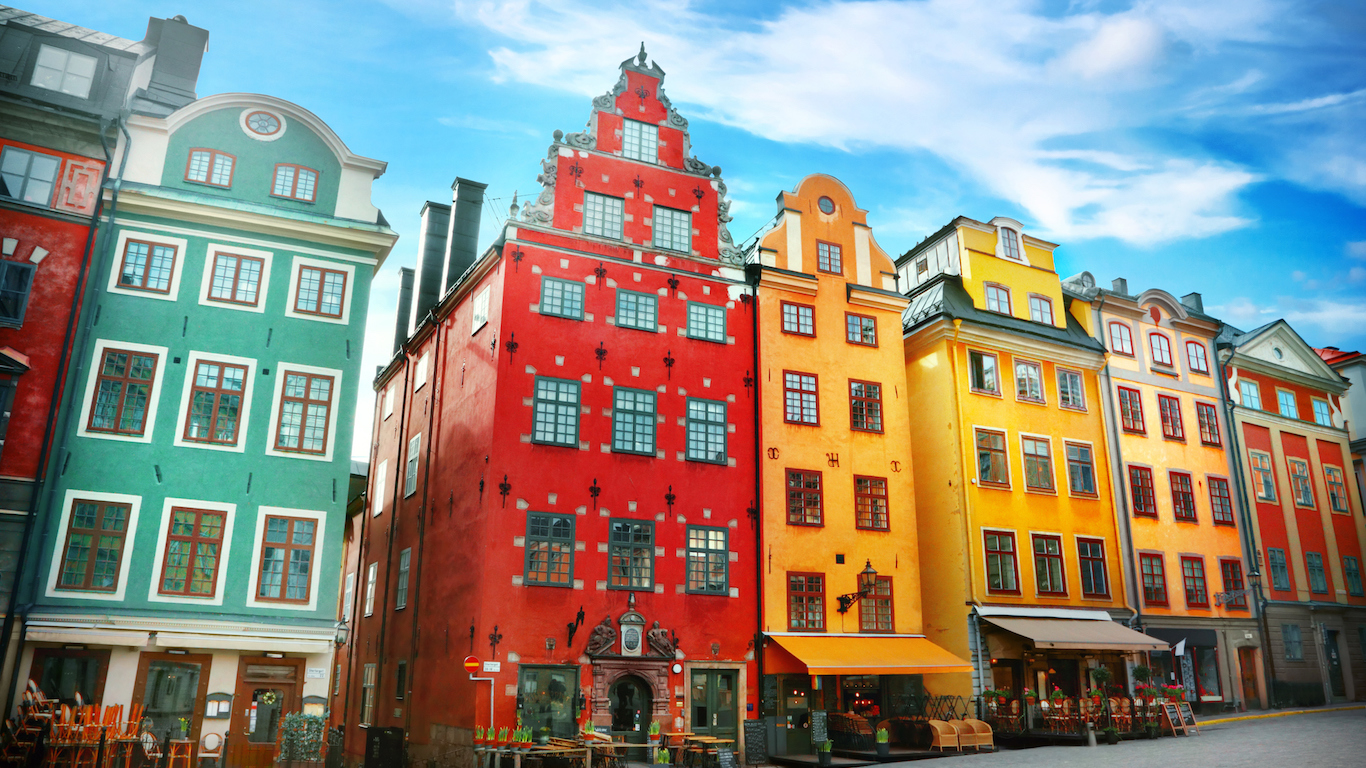
5. Sweden
> Life expectancy: 82.0
> Infant mortality rate (per 1,000 live births): 2.4
> Health expenditure per capita: $6,808
> GDP per capita: $48,199
Indicative of both a healthy population and capable medical facilities, childbirth is almost never fatal in Sweden. Both the country’s infant mortality and maternal mortality rates are nearly the lowest in the world. Additionally, life expectancy at birth in the country is 82 years, approximately three years longer than in the United States.
Long, healthy lives come at a cost in Sweden. The country spends $6,808 annually in both public and private investments on health care, more than all but four other countries reviewed. Like many other countries on this list, health care is a universal right in Sweden, ensured by the state.
[in-text-ad]

4. Singapore
> Life expectancy: 82.6
> Infant mortality rate (per 1,000 live births): 2.1
> Health expenditure per capita: $2,752
> GDP per capita: $85,382
The presence of tuberculosis, all but eliminated in many affluent nations, is often a sign of deficiencies in a country’s health system. Compared to many of the healthiest nations, the incidence rate of tuberculosis in Singapore — at 44 new cases each year per 100,000 residents — is somewhat high. While it is an outlier in this regard, the southeast Asian city-state is in most measures one of the healthiest nations on earth.
The average life expectancy at birth of 82.6 years is 3.7 years longer than in the United States. Singapore also has one of the lowest infant and maternal mortality rates of any nation.

3. Italy
> Life expectancy: 82.7
> Infant mortality rate (per 1,000 live births): 2.9
> Health expenditure per capita: $3,258
> GDP per capita: $35,781
Indicative of both a healthy population and an effective health care system, tuberculosis is relatively rare in Italy. The Mediterranean country’s annual tuberculosis incidence rate of 5.8 diagnosis per 100,000 people is well below all but a handful of other nations.
Like many other countries on this list, Italians are guaranteed essential health care services through their government. Despite universal coverage, Italy spends far less on health care than the United States. Public and private health care costs amount to $3,258 per person a year in Italy, a fraction of the $9,403 per capita annual health care expenditure in the United States.

2. Japan
> Life expectancy: 83.6
> Infant mortality rate (per 1,000 live births): 2.0
> Health expenditure per capita: $3,703
> GDP per capita: $38,142
The Japanese are more likely to live longer and healthier lives than residents of nearly any other country. Life expectancy at birth in the east Asian nation is 83.6 years, the longest of all countries considered.
Health insurance coverage is universal in Japan, and patients are only responsible for a maximum of 30% of their medical bills. Additionally, according to the most recent available data from the World Bank, there are 14.1 hospital beds in the country for every 1,000 residents, far and away the most in the world among those with available data. Japan’s health care system changed recently, implementing new surcharges and incentivizing certain preventative dental treatments as the country’s rapidly-aging population is putting considerable strain on the system.
[in-text-ad-2]
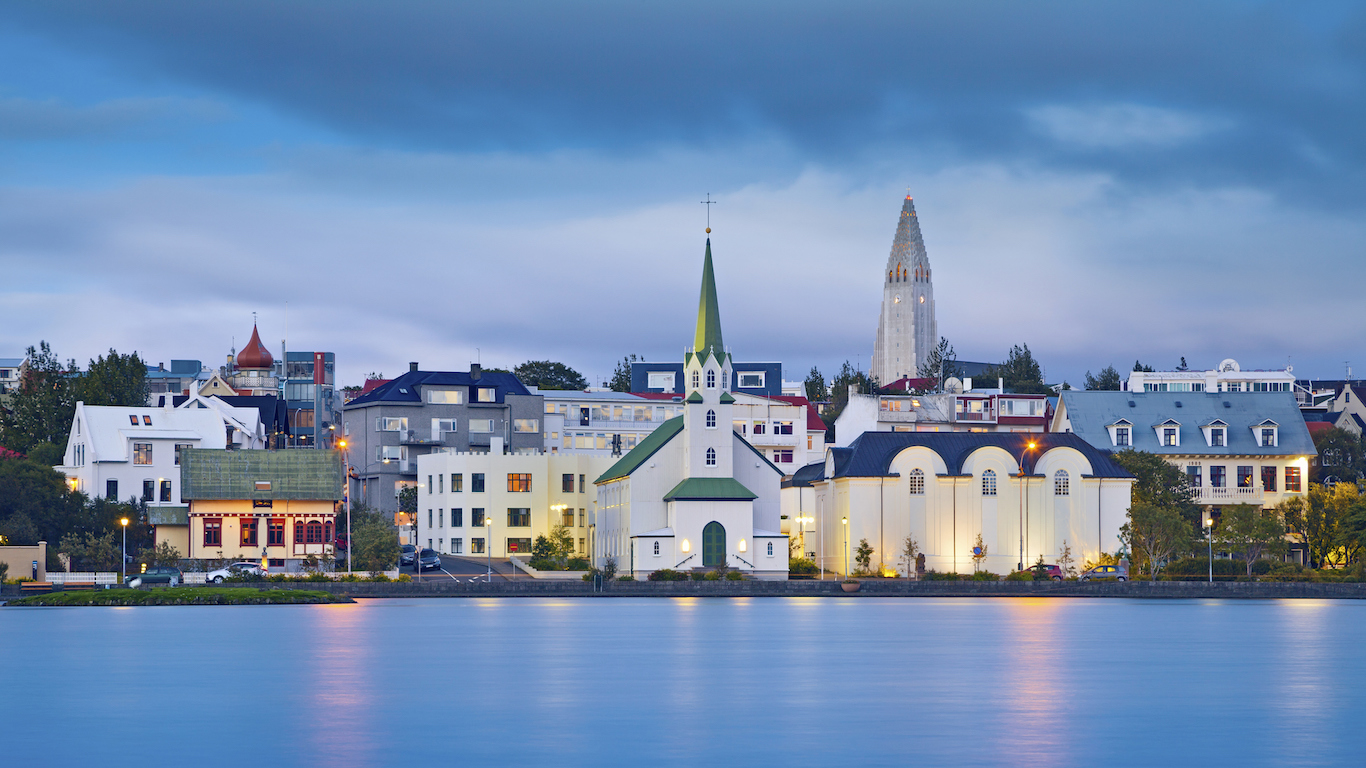
1. Iceland
> Life expectancy: 82.1
> Infant mortality rate (per 1,000 live births): 1.6
> Health expenditure per capita: $4,662
> GDP per capita: $45,666
The small nation of Iceland ranks as the healthiest country in the world. Iceland performs better than most nations in life expectancy, infant and maternal mortality, and incidence of diseases like tuberculosis.
Like many of the healthiest nations, health spending is quite high in Iceland, with the equivalent of $4,662 per capita spent on health care. Iceland has a state-funded, universal health care system. Icelanders are also required by law to register with a physician, which may further increase the frequency with which residents receive preventative care.
The Least Healthy Countries
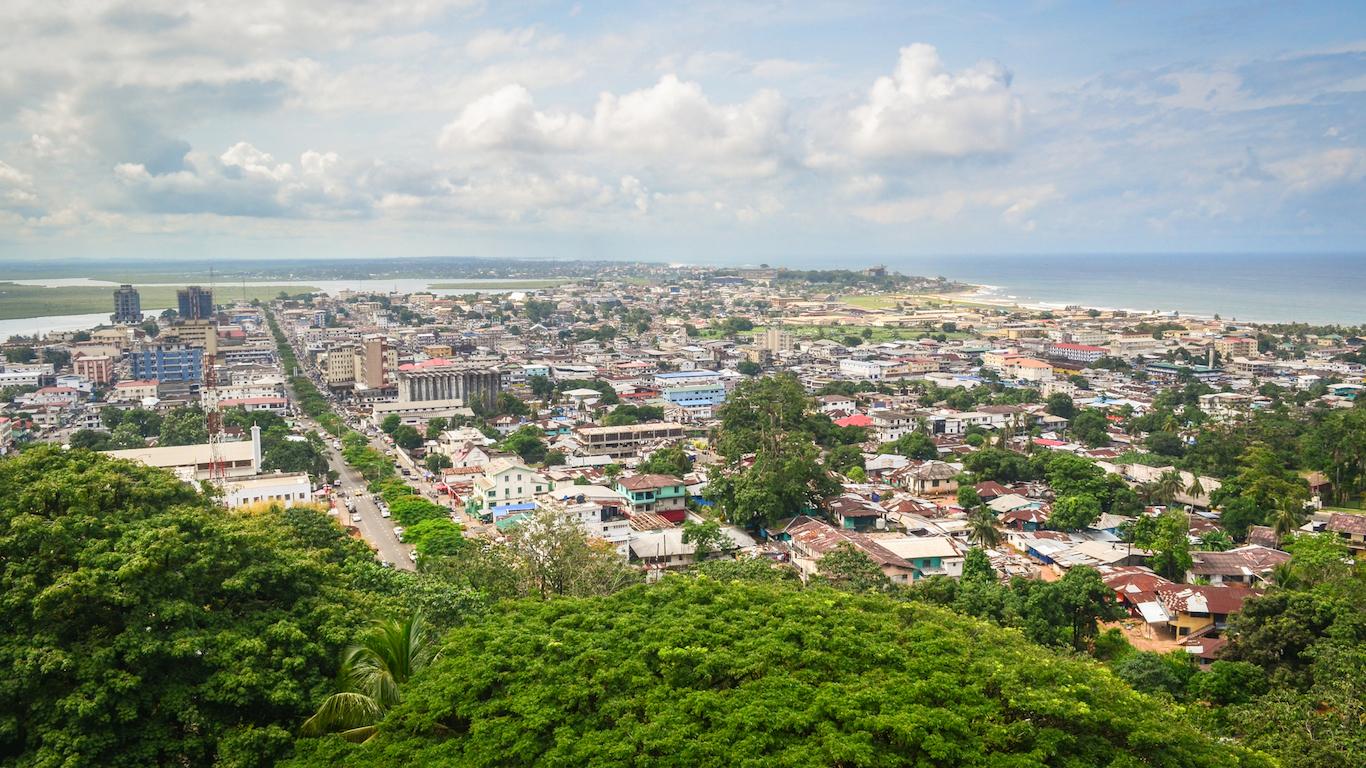
10. Liberia
> Life expectancy: 60.8
> Infant mortality rate (per 1,000 live births): 52.8
> Health expenditure per capita: $46
> GDP per capita: $875
Still recovering from a bloody and destructive civil war in the 1990s, Liberia today lacks many of the infrastructural elements necessary for good public health. Less than 10% of the population has access to electricity, and roughly one in every four residents lacks access to sanitized water. Such poor access to basic necessities likely heavily contributes to Liberia’s poor health outcomes, which are some of the worst on the planet. The infant mortality rate in Liberia, at 53 deaths for every 1,000 births, is one of the highest of any country. While the maternal mortality rate in many advanced countries is less than five maternal deaths per 100,000 live births, in Liberia an average of 725 women die per 100,000 births — nearly the highest rate of any country.
[in-text-ad]

9. South Africa
> Life expectancy: 57.2
> Infant mortality rate (per 1,000 live births): 33.6
> Health expenditure per capita: $570
> GDP per capita: $13,209
Tuberculosis, a potentially deadly disease primarily affecting young adults — common in impoverished countries — is a major problem in South Africa. There are 834 new incidents of tuberculosis for every 100,000 people annually, the highest TB rate of any country considered.
The country also faces a serious HIV problem. Nearly one in every five South Africans between the ages of 15 and 49 are HIV positive, one of the highest such shares in the world. A lack of education surrounding the disease may be partially to blame. The country’s president, Jacob Zuma, famously claimed he once showered after having sex with an HIV positive woman to reduce the likelihood of being infected.
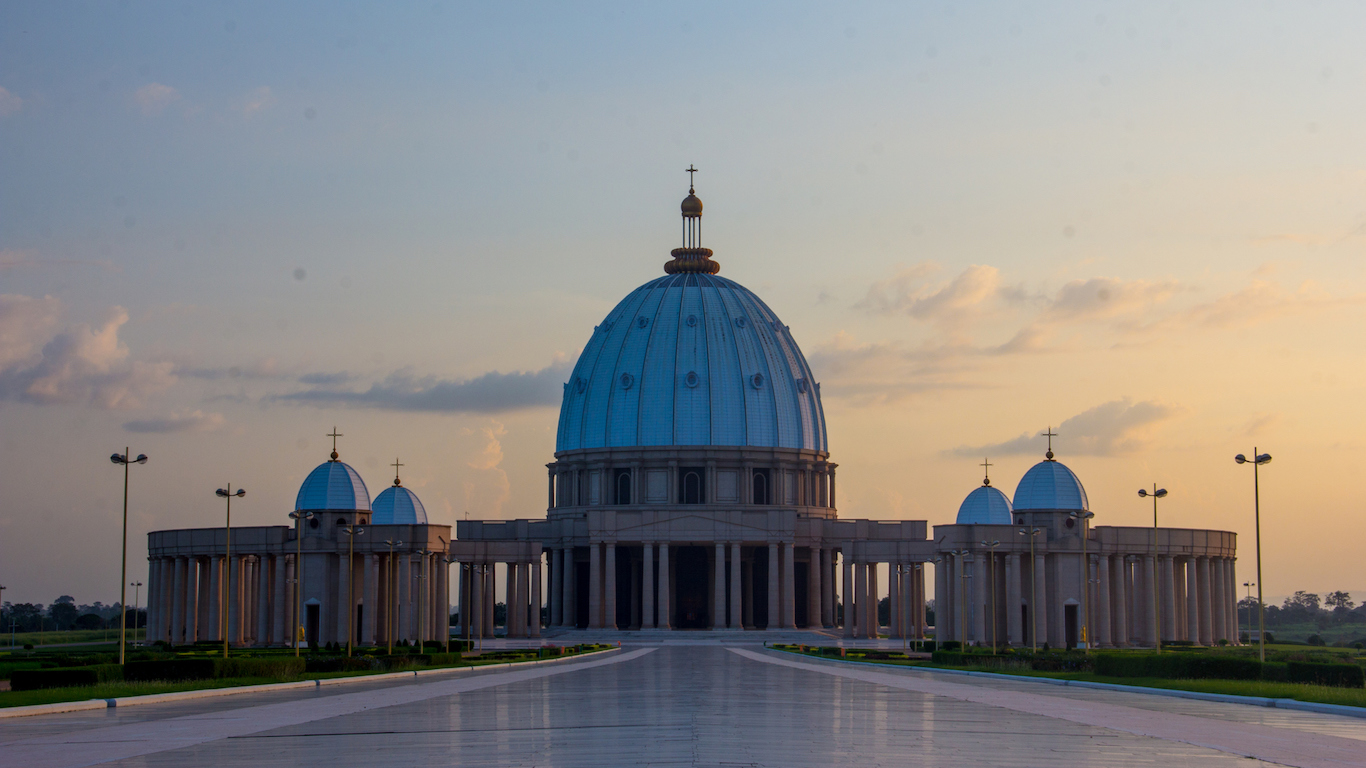
8. Cote d’Ivoire
> Life expectancy: 51.6
> Infant mortality rate (per 1,000 live births): 66.6
> Health expenditure per capita: $88
> GDP per capita: $3,359
While there was relative peace in Ivory Coast for several decades after the country gained independence from France in 1960, a military rebellion in 2002 ignited a period of violence and instability that left thousands dead and much of the nation’s infrastructure in disrepair. Just 56% of the Ivory Coast population today has access to electricity, and nearly one in five residents lack access to sanitized water. The average life expectancy at birth in the country of just 52 years is nearly the lowest in the world and 27 years less than the U.S. life expectancy of about 79 years.
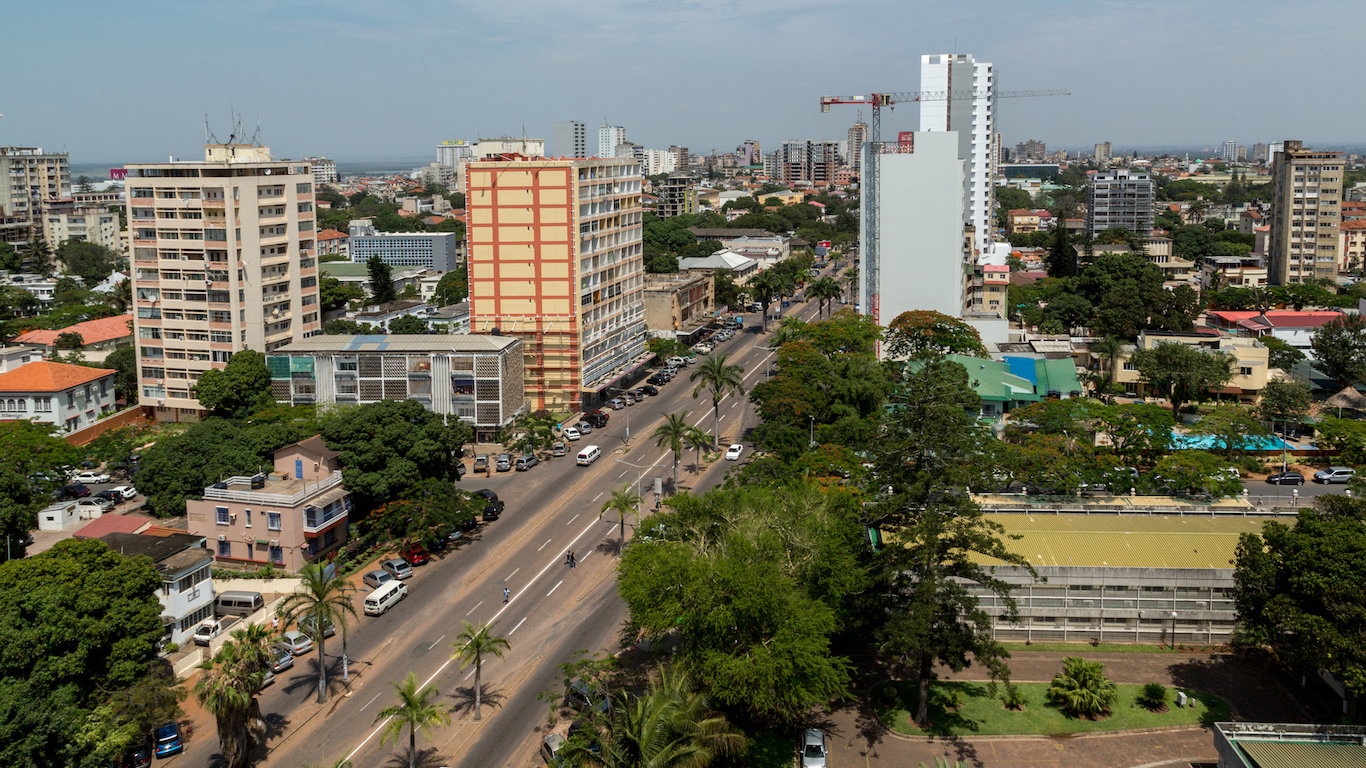
7. Mozambique
> Life expectancy: 55.0
> Infant mortality rate (per 1,000 live births): 56.7
> Health expenditure per capita: $42
> GDP per capita: $1,192
Many Mozambicans lack access to basic infrastructure that people in healthier countries take for granted. Only about half of the country’s population has access to clean water, and only 20% have access to electricity. Such access is even scarcer in the country’s rural areas. Lack of access to modern amenities likely contributes the country’s low 55 year life expectancy.
Like many unhealthy countries, health spending in Mozambique is relatively low. Combined annual public and private health care expenditure amounts to only about $42 per capita. In comparison, annual U.S. health care spending tops $9,400. Low investment in health care is partially the consequence of weak economic conditions. The country’s official unemployment rate of 22.6% is among the worst in the world.
[in-text-ad-2]
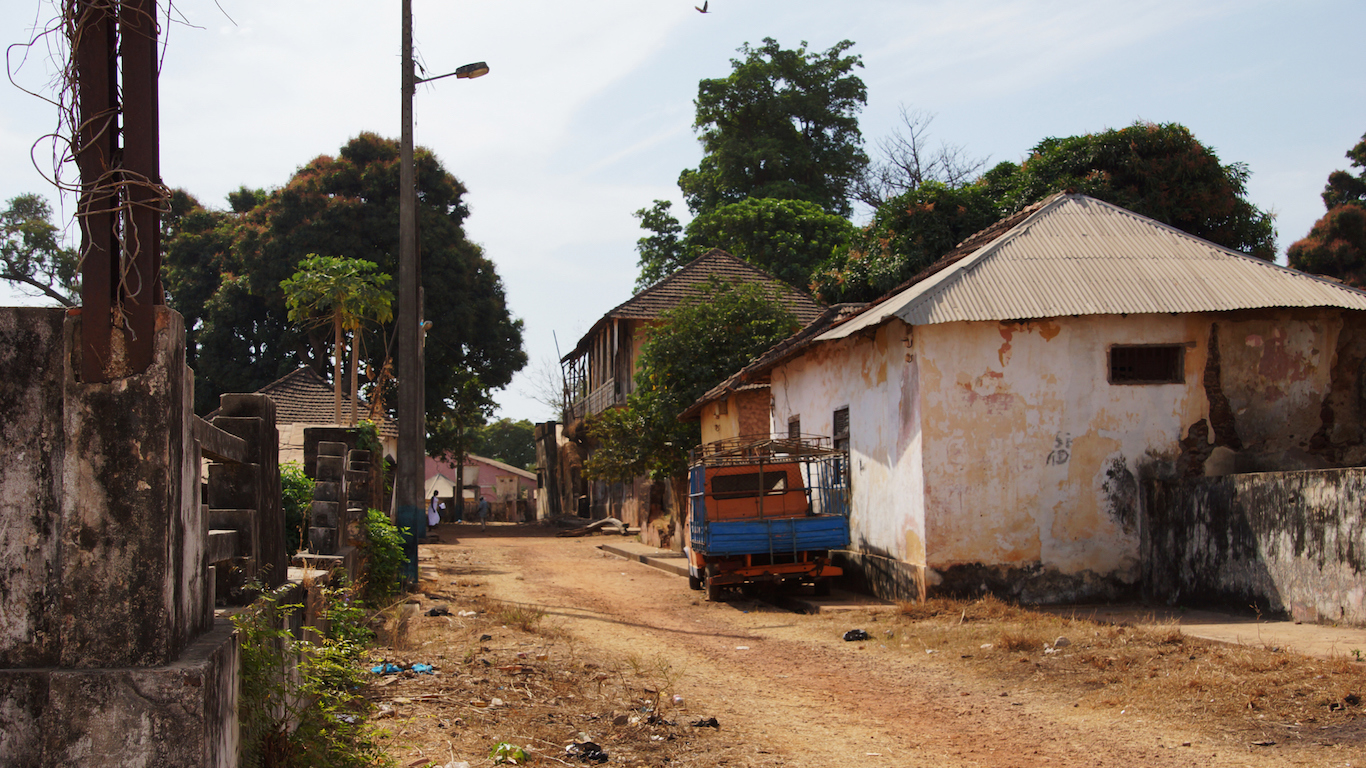
6. Guinea-Bissau
> Life expectancy: 55.2
> Infant mortality rate (per 1,000 live births): 60.3
> Health expenditure per capita: $37
> GDP per capita: $1,511
Childbirth is far riskier for both mothers and infants in Guinea-Bissau than it is in most other countries. Infants are over 10 times more likely to die within the first year of life in the West African nation than in the United States. Similarly, the maternal mortality rate during childbirth is nearly 40 times the U.S. rate.
Progress, as measured by health outcomes, is likely hindered by inadequate infrastructure and education. For example, slightly more than half of the population of 1.8 million lives in rural areas, many of whom lack basic amenities. Only 60.3% of the country’s rural residents have access to clean water, and 21.5% have access to electricity.
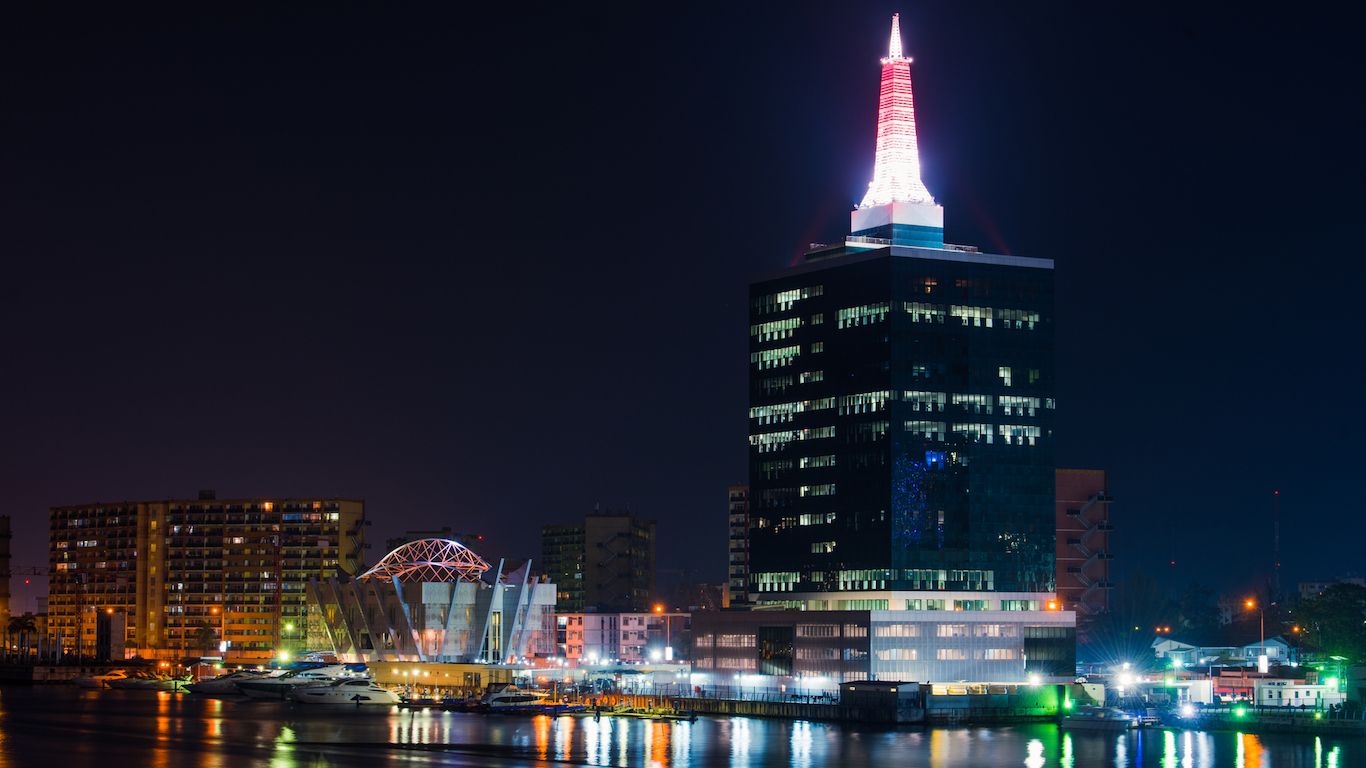
5. Nigeria
> Life expectancy: 52.8
> Infant mortality rate (per 1,000 live births): 69.4
> Health expenditure per capita: $118
> GDP per capita: $6,121
Despite Nigeria’s vast proven oil reserves — the second most of any country in Africa and the 10th most in the world — instability in the region has hindered foreign investment and limited economic development. Currently the seventh most populous country, Nigeria is expanding at a rapid pace and is on track to be the third most populous in the world by 2050. With resources spread thin across the nation, just $118 is spent on health care per Nigerian annually, approximately 1% of the health care expenditure for the average American. The country’s average life expectancy at birth is just 53 years, 26 years less than the U.S. life expectancy.
[in-text-ad]

4. Swaziland
> Life expectancy: 48.9
> Infant mortality rate (per 1,000 live births): 44.5
> Health expenditure per capita: $248
> GDP per capita: $9,712
The average person born in the southern African monarchy of Swaziland today is expected to live to be just 48.9 years old, 30 years less than the average person born in the United States today. Chief among the many factors contributing to the nation’s poor health is the AIDS epidemic. According to UNICEF, Swaziland has the highest recorded incidence rate of HIV on Earth. The World Bank estimates that a staggering 28.8% of the population aged 15-49 is afflicted with the virus.
HIV/AIDS is not the only deadly disease presenting a national health crisis in Swaziland. The country has nearly the highest annual incidence rate of tuberculosis. Approximately 7% of deaths are due to TB, making it the third leading cause of death in the country.
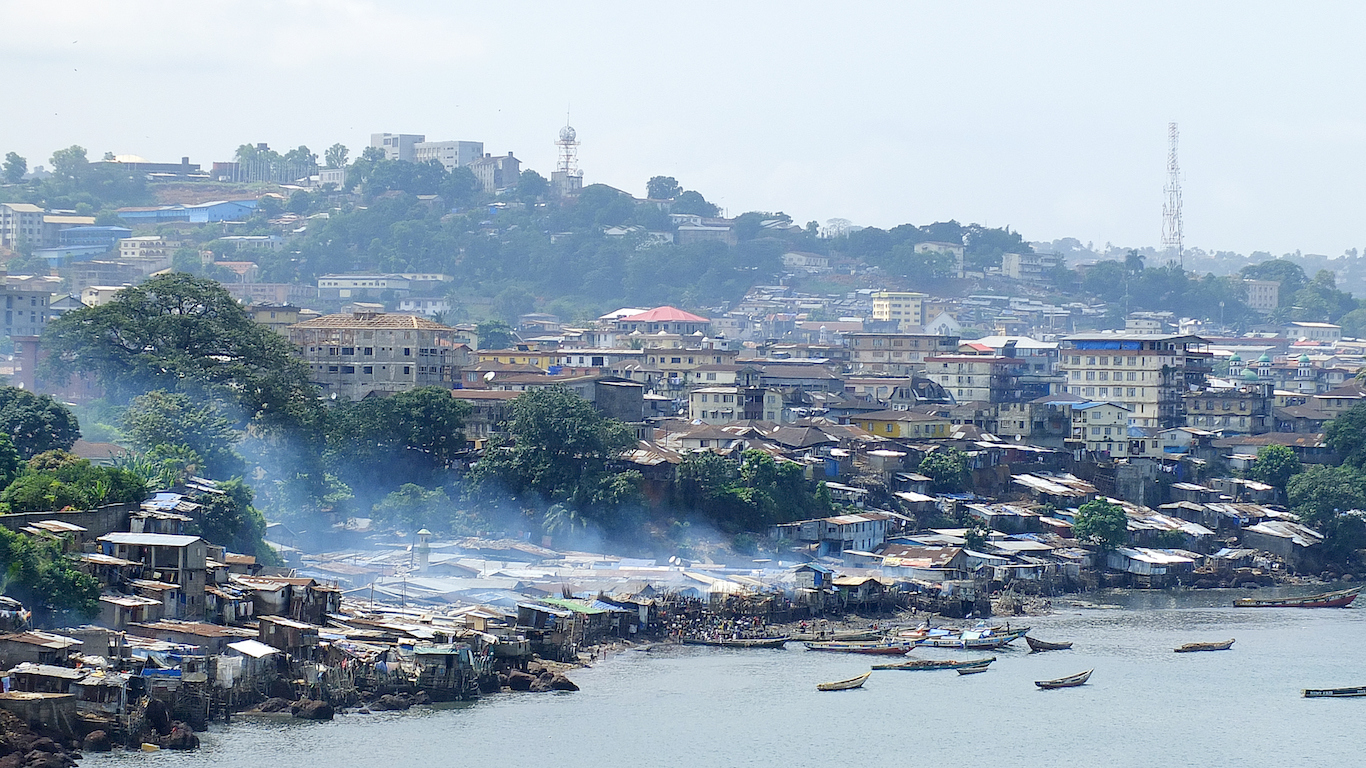
3. Sierra Leone
> Life expectancy: 50.9
> Infant mortality rate (per 1,000 live births): 87.1
> Health expenditure per capita: $86
> GDP per capita: $1,593
Indicative of poor overall health and health care facilities, child birth is significantly more deadly in Sierra Leone than anywhere else in the world. Some 1,360 mothers die during childbirth for every 100,000 live births each year, by far the worst maternal mortality rate of any country considered. Not surprisingly, life expectancy is also extremely low. At birth, the typical Sierra Leone resident is expected to live only 50.9 years.
Sierra Leone resembles most other unhealthy countries in several measures. Slightly more than 60% of the country’s 6.3 million residents live in rural areas, and many lack basic amenities. Only 47.8% of the nation’s rural population has access to clean water, and almost none have access to electricity.

2. Central African Republic
> Life expectancy: 50.7
> Infant mortality rate (per 1,000 live births): 91.5
> Health expenditure per capita: $16
> GDP per capita: $628
Infant and maternal mortality rates are often used as proxies for both the health of the population and the quality of the health system. In Central African Republic, about 880 mothers die for every 100,000 live births, and roughly 90 children die before the age of one for every 1,000 live births — each nearly the highest rate in the world.
The country’s poor health outcomes are also tied to conditions accompanying extreme poverty, such as the population’s minimal access to medical treatment and healthy food. The nation’s GDP per capita of $628 is one-89th the U.S. GDP per capita. As might be expected, annual health spending in CAR is also extremely low, at just $16 per person. In dozens of nations, at least $1,000 is spent per person on health.
[in-text-ad-2]

1. Lesotho
> Life expectancy: 49.7
> Infant mortality rate (per 1,000 live births): 69.2
> Health expenditure per capita: $105
> GDP per capita: $3,003
Lesotho is encompassed entirely by South Africa, another country with some of the worst health outcomes in the world. Like its neighbor, both TB and HIV are major problems in Lesotho. For every 100,000 people, there are 788 new cases of tuberculosis annually, and 22.7% of country residents aged 15-49 are HIV positive — each the second largest share of any country with available data. Some unhealthy behaviors vary considerably by gender. While only 0.4% of women smoke, slightly more than half of men do.
Like many unhealthy countries, Lesotho is primarily rural. Only 27.3% of the country’s 1.9 million residents live in urban areas, which tend to have greater access to basic amenities like electricity and clean water.
Methodology
To determine the most and least healthy countries, 24/7 Wall St. reviewed infant mortality rates (per 1,000 live births), maternal mortality rates (per 100,000 live births), life expectancy at birth, and the incidence of tuberculosis — a widely-used approximation of disease incidence — in 170 countries from data published by the World Bank. We normalized values using the min-max method and took the geometric mean to compare countries.
Up-to-date health measures comparable globally are often very limited. We only considered data that was available for at least 75% of the countries on our list, and we excluded countries with fewer than 250,000 people. We used data for the most recent year available.
In addition to health measures used in the ranking, we collected data on access to health services. We looked at the share of a country’s population with access to clean water, clean air, and electricity — all data came from the World Bank.
We also reviewed per capita health expenditure by public and private sources, as well as adult literacy rates, unemployment rates, population counts, and smoking rates. All economic data came from the World Bank.
The thought of burdening your family with a financial disaster is most Americans’ nightmare. However, recent studies show that over 100 million Americans still don’t have proper life insurance in the event they pass away.
Life insurance can bring peace of mind – ensuring your loved ones are safeguarded against unforeseen expenses and debts. With premiums often lower than expected and a variety of plans tailored to different life stages and health conditions, securing a policy is more accessible than ever.
A quick, no-obligation quote can provide valuable insight into what’s available and what might best suit your family’s needs. Life insurance is a simple step you can take today to help secure peace of mind for your loved ones tomorrow.
Click here to learn how to get a quote in just a few minutes.
Thank you for reading! Have some feedback for us?
Contact the 24/7 Wall St. editorial team.